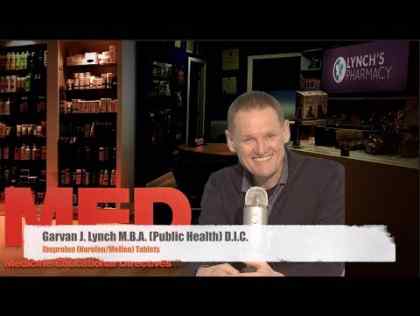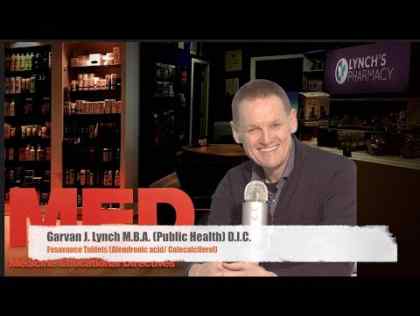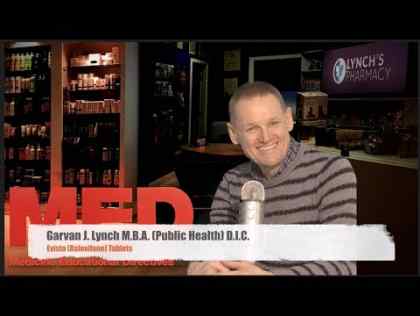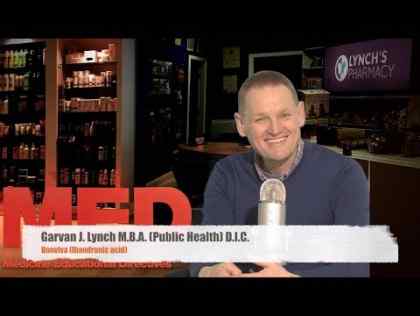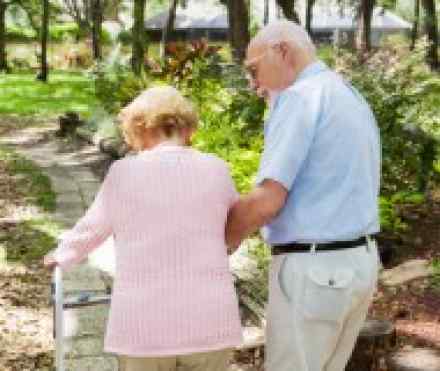
What is it?
Osteoporosis, which means "porous bones," causes bones to become weak and brittle — so brittle that a fall or even mild stresses like bending over or coughing can cause a fracture. In many cases, bones weaken when you have low levels of calcium and other minerals in your bones.
A common result of Osteoporosis is fractures — most of them occur in the spine, hip or wrist. Although it's often thought of as a women's disease, Osteoporosis affects men too. And aside from people who have Osteoporosis, many others have low bone density, putting them at risk of developing Osteoporosis.
It's never too late — or too early — to do something about Osteoporosis. You can take steps to keep bones strong and healthy throughout life.
How do I recognise it?
In the early stages of bone loss, you usually have no pain or other symptoms. But once bones have been weakened by Osteoporosis, you may have Osteoporosis signs and symptoms that include:
- Back pain, which can be severe, as a result of a fractured or collapsed vertebra
- Loss of height over time
- A stooped posture
- Fracture of the vertebra, wrist, hip or other bone
Causes
Scientists don't yet know exactly why Osteoporosis occurs, but they do know that the normal bone remodeling process is disrupted.
Other factors, such as hormone levels, also affect bone density. In women, when estrogen levels drop at menopause, bone loss increases dramatically. In men, low estrogen and testosterone levels can cause a loss of bone mass.
How do you treat it?
Like any disease, even if there is no cure, there is almost always something you can do to manage it and take control. There are three main areas involved in the treatment of any disease:
- Conventional medicines
- Complementary medicines
- Complementary therapies
Conventional medicine
Medications
A number of medications are available to help slow bone loss and maintain bone mass, including:
- Bisphosphonates. Much like estrogen, this group of drugs can inhibit bone breakdown, preserve bone mass, and even increase bone density in your spine and hip, reducing the risk of fractures. Examples of these medications include Fosamax, Boniva, Actonel and Zometa. Side effects, which can be severe, include nausea, abdominal pain, difficulty swallowing and the risk of an inflamed esophagus or esophageal ulcers. Bisphosphonates that can be taken once a week or once a month may cause fewer stomach problems.
- Raloxifene (Evista). Raloxifene mimics estrogen's beneficial effects on bone density in postmenopausal women, without some of the risks associated with estrogen, such as increased risk of uterine cancer and, possibly, breast cancer. Hot flashes are a common side effect of raloxifene, and you shouldn't use this drug if you have a history of blood clots.
- Calcitonin. A hormone produced by your thyroid gland, calcitonin reduces bone resorption and may slow bone loss. It may also prevent spine fractures, and may even provide some pain relief from compression fractures. It's usually administered as a nasal spray (Miacalcic) and may cause nasal irritation in some people who use it, but it's also available as an injection. Because calcitonin isn't as potent as bisphosphonates, it's normally reserved for people who can't take other drugs.
- Teriparatide (Forsteo). This powerful drug treats osteoporosis in postmenopausal women and men who are at high risk of fractures. It works by stimulating new bone growth, while other medications prevent further bone loss. Teriparatide is given once a day by injection under the skin on the thigh or abdomen. Long-term effects are still being studied, so therapy is recommended for two years or less.
- Medications are often given in conjunction with calcium and vitamin D supplements.
Hormone therapy
Estrogen, especially when started soon after menopause, can help maintain bone density. However, the use of hormone therapy can increase your risk of blood clots, endometrial cancer, breast cancer and possibly heart disease. Because of concerns about its safety and because other treatments are available, hormone therapy is generally not a first-choice treatment anymore.
Physical therapy
In addition to medications or hormones, physical therapy programs may help you build bone strength and improve your posture, balance and muscle strength, making falls less likely.
Alternative medicines
Strong scientific evidence exists for the following:
- Calcium: Calcium is the nutrient consistently found to be the most important for attaining bone mass and preventing osteoporosis. Adequate calcium and vitamin D are deemed essential for the prevention of osteoporosis in general, including postmenopausal osteoporosis. Avoid if allergic to calcium or lactose. High doses taken by mouth may cause kidney stones. Avoid with high levels of calcium in the blood, high levels of calcium in urine, hyperparathyroidism (overgrowth of the parathyroid glands), bone tumors, digitalis toxicity, ventricular fibrillation (rapid, irregular twitching of heart muscle), kidney stones, kidney disease.
- Vitamin D: Adequate vitamin D intake is required for optimal calcium absorption. Adults with severe Vitamin D deficiency lose bone mineral content and experience bone pain, muscle weakness, and “soft bones”. Avoid if allergic or hypersensitive to vitamin D or any of its components. Vitamin D is generally well-tolerated in recommended doses; doses higher than recommended may cause toxic effects. Vitamin D is safe in pregnant and breastfeeding women when taken in recommended doses.
Alternative therapies
- Physical therapy: Supervised or home-based physical therapy has been used in combination with resistance and endurance training in physically frail elderly women taking hormone replacement therapy to improve bone density. Although early study is promising, more studies are needed in this area. Not all physical therapy programs are suited for everyone, and patients should discuss their medical history with a qualified healthcare professional before beginning any treatments.
- Tai chi: Tai chi is a system of movements and positions believed to have developed in 12th Century China. Tai chi techniques aim to address the body and mind as an interconnected system and are traditionally believed to have mental and physical health benefits to improve posture, balance, flexibility, and strength. Preliminary research suggests that tai chi may be beneficial in delaying early bone loss in postmenopausal women and preventing osteoporosis. Additional evidence and long-term follow-up is needed to confirm these results. Avoid with severe osteoporosis or joint problems, acute back pain, sprains, or fractures. Avoid during active infections, right after a meal, or when very tired.
- Exercise: Exercise can help you build strong bones and slow bone loss. Exercise will benefit your bones no matter when you start, but you'll gain the most benefits if you start exercising regularly when you're young and continue to exercise throughout your life. Combine strength training exercises with weight-bearing exercises. Strength training helps strengthen muscles and bones in your arms and upper spine, and weight-bearing exercises — such as walking, jogging, running, stair climbing, skipping rope, skiing and impact-producing sports — mainly affect the bones in your legs, hips and lower spine. Swimming, cycling and exercising on machines such as elliptical trainers can provide a good cardiovascular workout, but because such exercises are low impact, they're not as helpful for improving bone health as weight-bearing exercises are.
- Stress management is also of use in osteoporosis. If you're stressed, it's easy to abandon your usual osteoporosis management routine. So learning a few relaxation techniques could be well worth your while.
- Relaxation techniques: Relaxation techniques are an essential part of your quest for stress management. Relaxation isn't just about peace of mind or enjoying a hobby. Relaxation is a process that decreases the wear and tear on your mind and body from the challenges and hassles of daily life.
- Yoga: Yoga has been shown to enhance quality of life, lower sleep disturbance and decrease stress symptoms.
- Aromatherapy: Aromatherapy uses fragrant oils to provide a calming sensation. Oils, infused with scents such as lavender, can be applied to your skin during a massage or the oils can be added to bath water. Fragrant oils also can be heated to release their scents into the air. Aromatherapy may be helpful in relieving nausea, pain and stress.
- Progressive relaxation exercises: These help you relax muscles in your body, one by one. Start by tightening the muscles in your feet, then concentrate on slowly letting all of the tension go. Next, tighten and relax your calves. Continue until the muscles in your body, including those in your eyes and scalp, are relaxed.
How do you live with it?
Coping Skills
The idea that your bones aren't as strong as they used to be can be frightening. You may find that talking to other people who also have Osteoporosis can be encouraging and helpful. Learn as much as you can about the condition and take ownership of it.
Helpful tips
These suggestions may help relieve symptoms and maintain your independence if you have Osteoporosis:
- Maintain good posture. Good posture — which involves keeping your head held high, chin in, shoulders back, upper back flat and lower spine arched — helps you avoid stress on your spine. When you sit or drive, place a rolled towel in the small of your back. Don't lean over while reading or doing handwork. When lifting, bend at your knees, not your waist, and lift with your legs, keeping your upper back straight.
- Prevent falls. Wear low-heeled shoes with nonslip soles and check your house for electrical cords, area rugs and slippery surfaces that might cause you to trip or fall. Keep rooms brightly lit, install grab bars just inside and outside your shower door, and make sure you can get in and out of your bed easily.
- Manage pain. Discuss pain management strategies with your doctor. Don't ignore chronic pain. Left untreated, it can limit your mobility and cause even more pain.
- Maintain a healthy weight. Having a healthy BMI [Body mass index} can protect your bones. A healthy BMI is between 20 - 25.
- Is you have a BMI less than 20 it may mean you are underweight and your bones have very little protection in the event of a fall. If you have a BMI in excess of 25 it may mean that you are overweight and this puts extra strain on your joints etc often preventing you from exercising. To calculate your BMI weight / (height x height)
If you want to lose weight
Do not cut out dairy products, more and more research shows us that dairy products can protect us from weight gain. Instead continue with the three a day message and choose lower fat options. Low fat or skimmed milk have the same amounts of calcium as full fat milk but may be lower in vitamin D so ensure that this is added back in.
Watch your Caffeine Intake
Caffeine is found in tea, coffee, energy drinks and colas and may cause us to excrete calcium in our urine. To prevent this from happening, limit your intake of these drinks to 4 /day. Try to include lattes and cappuccinos to boost milk intake.
Be Careful of your Alcohol Intake!
Excessive alcohol may increase your risk of Osteoporosis. The health promotion unit in Ireland recommends no more than 14 standard drinks/week for women and 21 standard drinks/week for men. A unit is equivalent to ½ pint beer/stout, 1 measure spirits, or a small glass of wine.
What if I am allergic to Dairy Products?
Allergy to the protein in cow’s milk is rare in adults and if present must be treated with a dairy free diet. Special attention must be given to other sources of calcium like fortified foods and soya products, which are fortified with calcium.
Diet and Osteoporosis
Diet plays a major role in ensuring healthy bones. In particular, Calcium and Vitamin D need to be taken in the right amounts through life to build bone and slow down bone loss. Eating a healthy balanced diet, containing adequate calories, can help to improve your overall bone health not to mention your overall health.
Bone development
It is important to look after your bones no matter what your age. While 90% of adult bone is laid down by the age of 17, bone continues to grow in strength up until the mid-thirties. After this, it is natural to lose a small amount of bone each year. This is accelerated in women after the menopause when the protective effect of oestrogen is lost. However, calcium, Vitamin D and regular exercise help maintain bone strength and minimise bone loss. The Department of Health and Children recommend that children, adults and older people include three servings of calcium rich foods per day. The easiest way to obtain this is through the regular consumption of milk, cheese and yogurt i.e. 3 servings each day from the milk group of foods. Teenagers and pregnant women need five servings each day.
Exercising & osteoporosis
If you have Osteoporosis, you might mistakenly think exercise will lead to fracture. In fact though, using your muscles helps protect your bones.
If you've always been physically active, even though your bones may lose some density as you age, they're less likely to become brittle enough to break if you slip and fall.
But it's not too late to start exercising after menopause, when the pace of bone loss really picks up. Even then, starting an exercise program will increase your muscle strength, improve your balance and help you avoid falls — and it may keep your bones from getting weaker.
Other possible benefits of exercise include:
- Increasing your ability to carry out daily tasks and activities
- Maintaining or improving your posture
- Relieving or lessening pain
- Increasing your sense of well-being
- The key to exercising with osteoporosis is to find the safest, most enjoyable activities for you, given your overall health and amount of bone loss. There's no one-size-fits-all prescription.
Before you start
Consult your doctor before starting any exercise program for Osteoporosis. You may need a bone density test and a fitness assessment first.
In the meantime, think about what kind of activities you enjoy most. If you choose an exercise you enjoy, you're more likely to stick with it over time.
Choosing the right form of exercise
Three types of activities are often recommended for people with Osteoporosis:
- Strength training exercises, especially those for the back
- Weight-bearing aerobic activities
- Flexibility exercises
Because of the varying degrees of Osteoporosis and the risk of fracture, certain exercises may be discouraged. Ask your doctor or physical therapist whether you're at risk of Osteoporosis-related problems, and find out what exercises are appropriate for you.
Strength training
Strength training includes the use of free weights, weight machines, resistance bands or water exercises to strengthen the muscles and bones in your arms and upper spine. Strength training can also work directly on your bones to slow mineral loss.
Weight-bearing aerobic activities
Weight-bearing aerobic activities involve doing aerobic exercise on your feet, with your bones supporting your weight. Examples include walking, dancing, low-impact aerobics, elliptical training machines, stair climbing and gardening.
Flexibility exercises
Being able to move your joints through their full range of motion helps you maintain good balance and prevent muscle injury. Increased flexibility can also help improve your posture. When your joints are stiff, your abdominal and chest muscles become tight, pulling you forward and giving you a stooped posture.
Movements to avoid
If you have Osteoporosis, don't do the following types of exercises:
- High-impact exercises, such as jumping, running or jogging. These activities increase compression in your spine and lower extremities and can lead to fractures in weakened bones. Avoid jerky, rapid movements in general. Choose exercises with slow, controlled movements.
- Exercises in which you bend forward and twist your waist, such as touching your toes, doing sit-ups or using a rowing machine. These movements also put pressure on the bones in your spine, increasing your risk of compression fractures. Other activities that may require you to bend or twist forcefully at the waist are golf, tennis, bowling and some yoga poses.
References
Osteoporosis- http://en.wikipedia.org/wiki/Osteoporosis
Osteoporosis, information for patients http://www.cks.nhs.uk/patient_information_leaflet/osteoporosis
http://www.mayoclinic.com/health/osteoporosis/DS00128/DSECTION=treatments%2Dand%2Ddrugs
http://www.riversideonline.com/health_reference/Womens-Health/WO00048.cfm


